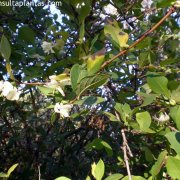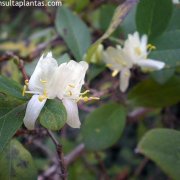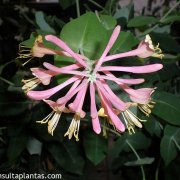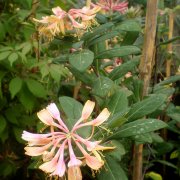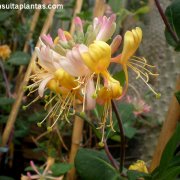Care of the climbing plant Lonicera periclymenum or Common honeysuckle |
|
The genus Lonicera, family Caprifoliaceae, comprises 100 species of shrubs and climbing plants native to the Northern Hemisphere. Some species are: Lonicera periclymemum, Lonicera nitida, Lonicera japonica, Lonicera implexa, Lonicera etrusca, Lonicera caprifolia, Lonicera sempervirens, Lonicera caerulea. Common names: Common honeysuckle, European honeysuckle, Woodbine. This species is native to western Europe. They are sarmentous deciduous shrubs that reach 4 meters (13.12 feet) in height. The leaves are opposite, oval in shape and deep green in color. The scented stumpy flowers can be yellowish, pink or purple in color. They bloom in summer. They produce globose red fruits. Common honeysuckle is used as climbing plants (it will need supports) to cover walls, pergolas or fences. Lonicera periclymenum needs exposure to full sun or light shade; prefers to have shade at the base (roots). Located in the sun they will produce more flowers than in semi-shade. It resists occasional frosts. The soil must be well drained and contain plenty of organic matter. Water frequently throughout the year so that the substrate is always damp but without ever flooding. Fertilize in autumn with humus or compost. Prune after flowering by cutting the branches to 1/3 of their length. Lonicera periclymenum is a quite resistant plant to the usual pests and diseases. European honeysuckle propagates by cuttings made in late summer or early fall. |
Images of the climbing plant Lonicera periclymenum or Common honeysuckle |
Find plants
Lonicera periclymenum or Common honeysuckle | Care and Growing
© 2026 FavThemes
